Carrier A98426 Programmable Thermostats
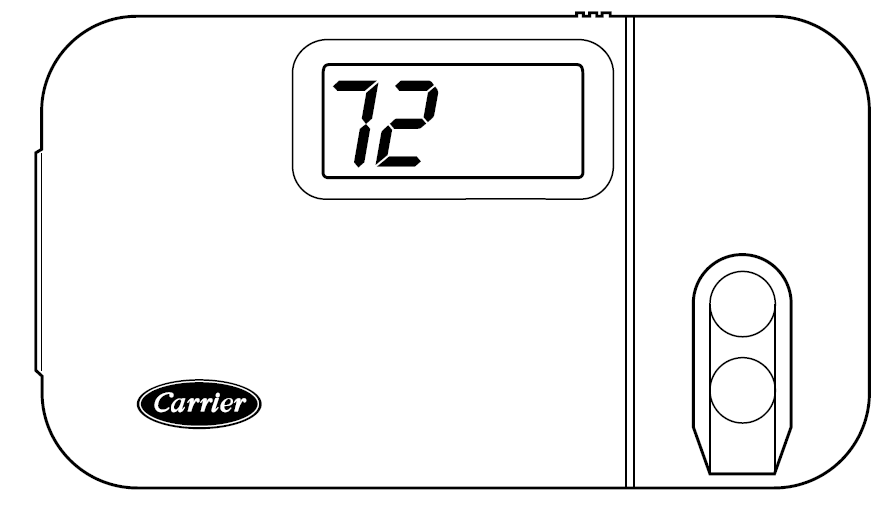
SAFETY CONSIDERATIONS
Read and follow manufacturer instructions carefully. Follow all local electrical codes during installation. All wiring must conform to local and national electrical codes. Improper wiring or installation may damage thermostat.
Recognize safety information. This is the safety-alert symbol. When you see this symbol on the equipment and in the instruction manual, be alert to the potential for personal injury. Understand the signal words DANGER, WARNING, and CAUTION. These words are used with the safety-alert symbol. DANGER identifies the most serious hazards which will result in severe personal injury or death. WARNING signifies a hazard which could result in personal injury or death. CAUTION is used to identify unsafe practices which would result in minor personal injury or product and property damage.
INTRODUCTION
Carrier’s 7-day programmable thermostats are wall-mounted, lowvoltage thermostats which maintain room temperature by controlling the operation of a heating and air conditioning system. Separate heating and cooling setpoints, plus auto changeover allow setback programming for maximum energy savings. All of the thermostats allow up to 4 time/temperature settings to be programmed per 24 hr period and store programs for 7 independentdays. Batteries are not required; during a power interruption, the internal memory stores programs for an unlimited time and the clock continues to run for at least 72 hrs.
INSTALLATION CONSIDERATIONS
- Power
Note that all TSTAT models require no batteries and are not “power stealing”. They do require 24VAC (R and C terminals) to be connected for proper operation. Thermostat will not operate without these 2 connections. - Models
There are 3 different models. The 9th and 10th letters of the part number indicate the model. These 2 letters appear on the package and on the circuit board. Be sure to have the proper thermostat for the intended application. Models are:- AC – 1-stage cool, 1-stage heat – for AC systems only.
- HP – 1-stage cool, 2-stage heat – for either HP or AC with 2-stage heat.
- 2S – 2-stage cool, 2-stage heat – for 2-speed AC systems, or
- 2-stage cool, 3-stage heat – for 2-speed HP systems, or
- 1-stage cool, 4-stage heat – for 1-speed HP with special
- 3-stage electric heat.
Use each only for its intended purpose.
- Outdoor Temperature Sensing
All Carrier programmable thermostats may be equipped with an optional outdoor temperature sensor, Part No.TSTATXXSEN01-B. If it is to be used, plan installation so that 2 wires can be run from the thermostat to an outdoor location, preferably on the north side of the house OR refer to Installation Instructions included with the outdoor temperature sensor forsimplified connection. Sensor can be mounted to outdoor unit and existing control wires used for its connection. Details are provided to the sensor instructions.
INSTALLATION
Step 1—Thermostat Location Thermostat should be mounted:
- Approximately 5 ft (1.5m) from floor.
- Close to or in a frequently used room, preferably on an inside partitioning wall.
- On a section of wall without pipes or duct work.
Thermostat should NOT be mounted: - Close to a window, on an outside wall, or next to a door leading to the outside.
- Exposed to direct light and heat from a lamp, sun, fireplace, or other temperature-radiating object which may cause a false reading.
- Close to or in direct airflow from supply registers and return-air grilles.
- In areas with poor air circulation, such as behind a door or in an alcove.
Step 2—Set DIP Switches
There is a 4 section DIP switch within the thermostat which must be properly set by the installer. It is easiest to set these 4 switches before the thermostat is mounted to the wall, so STOP and complete the following steps:
- Open hinged thermostat cover.
- Remove cover completely by snapping it apart at hinge.
- Open thermostat by pressing back half of the right end of plastic case inward while, at the same time, pulling front and back halves apart at the right end. The 2 halves will swing apart.
- Snap hinge apart to completely separate the 2 halves.
- Switches are located in upper right corner of circuit board. To change switch position, use corner of a small screwdriver to slide switch to opposite position.
- After switches have been set, do not reassemble the 2 halves.
The rear plastic will be first mounted to wall.
Switch A – Zoning Select (Active on all models)
This switch selects or defeats the 4 cycles per hour limit and a 5-minute compressor timeguard. These timers MUST be enabled for normal operation and disabled for zoning applications. (In zoning applications the zone control center performs these timing functions.)
TO SET:
OFF— for normal operation. This is the factory default.
ON—for zoned installations ONLY.
Switch B – Setback Recovery (Active on all models)
Selects between normal and smart recovery from setback. Normal recovery changes to the new setpoint at the programmed time. Smart recovery, which is active in heating mode only, starts earlier and adjusts the setpoint slowly so that room temperature will arrive at the programmed temperature at the programmed time.
TO SET:
OFF—for smart recovery. This is the factory default.
ON—for normal recovery.
Switch C – HP/AC Select (Active on HP and 2S models only)
Use to select between AC and HP installations. HP and 2S models have an extra relay to control the HP reversing valve. When a HP thermostat is placed in the AC mode, this extra relay is converted to a second stage heat output. This allows thermostat control of 2-stage furnaces or 2-stage strip heat with AC systems. (AC mode also uses W rather than Y for first-stage heat.)
TO SET:
OFF—for HP applications. Extra relay controls reversing valve.
This is factory default.
ON—for AC applications. Extra output can be used for 2-stage heat.
Switch D – Intelligent Heat Staging Select (Active on 2S models only)
This switch converts a 2-speed heat pump thermostat with 1 stage of auxiliary heat into a 1-speed heat pump thermostat with 3 stages of auxiliary heat for comfortable leaving air temperature. It requires selected heaters with 2:1 ratio element sizes plus an FK, FV, 40FKA fan coil. Refer to variable-speed fan coil literature for details.
TO SET:
OFF—for normal 2-speed operation. This is factory default.
ON—for intelligent 3-stage heat with FK, FV, 40FKA fan coil.
Step 3—Install Thermostat
WARNING
Before installing thermostat, turn off all power to unit. There may be more than 1 power disconnect. Electrical shock can cause personal injury or death.
- Turn OFF all power to unit.
- If an existing thermostat is being replaced:
- Remove existing thermostat from wall.
- Disconnect wires from existing thermostat, 1 at a time. Be careful not to allow wires to fall back into the wall.
- As each wire is disconnected, record wire color and terminal marking.
- Discard or recycle old thermostat.
NOTE: Mercury is a hazardous waste and MUST be disposed of properly.
- Open thermostat rear door (mounting base) to expose mounting holes. The base can be removed to simplify mounting. Snap apart carefully at hinge to separate mounting base from remainder of thermostat.
- Route thermostat wires through large hole in mounting base. Level mounting base against wall (for aesthetic value only—thermostat need not be leveled for proper operation) and mark wall through 2 mounting holes.
- Drill two 3/16-in. mounting holes in wall where marked.
- Secure mounting base to wall with 2 screws and anchors provided, (additional anchoring holes available for moresecure mounting if needed) making sure all wires extend through hole in mounting base.
- Adjust length and routing of each wire to reach proper terminal and connector block on mounting base with 1/4 in. of extra wire. Strip only 1/4 in. of insulation from each wire to prevent adjacent wires from shorting together when connected.
- Match and connect equipment wires to proper terminals of the connector blocks. (See Table 1, and Fig. 2 through 24.) Both R and C must be connected for proper thermostat operation.
CAUTION
Improper wiring or installation may damage the thermostat. Check to make sure wiring is correct before proceeding with installation or turning on unit. - Push any excess wire into wall and against mounting base. Seal hole in wall to prevent air leaks. Leaks can affect operation.
- Snap hinge back together.
- Close thermostat assembly making sure pins on back of circuit board align with sockets in connector.
INDOOR UNIT AIR CONDITIONER HEAT PUMP 1 Speed 2 Speed 1 Speed 2 Speed 1-Stage Furnace Model AC See Fig. 2 Model 2S See Fig. 8 Requires Dual Fuel Ther- mostat Model 2S See Fig. 11 2-Stage Furnace Model AC See Fig. 3 Model HP See Fig. 4 Model 2S See Fig. 9 Requires Dual Fuel Ther- mostat Model 2S See Fig. 12 Typical Fan Coil Model AC See Fig. 5 Model HP See Fig. 6 Model 2S See Fig. 10 Model HP See Fig. 7 Model 2S See Fig. 13 Variable-Speed (FK, FV, 40FKA) Fan Coil
Model AC See Fig. 15 Model HP See Fig. 16 Model 2S See Fig. 17 Model 2S See Fig. 14 Model 2S See Fig. 18 - Turn ON power to unit.
On power up, all display segments will light for 5 sec. For the next 5 sec, a 2-digit code appears on large display which identifies thermostat configuration:- AC—for 1-speed air conditioner
- HP—for 1-speed heat pump
- A2—for 2-speed air conditioner
- H2—for 2-speed heat pump
- HS—for intelligent heat staging with FK, FV, 40FKA Fan Coil and 1-speed heat pump
When this identifier disappears, normal operation begins. The MODE control should be set to OFF and FAN control to AUTO, so equipment does not start until further configuration and checkout is completed.
Step 4—Set Thermostat Configuration
Configuration options, like DIP switch settings, are intended to be selected at installation and normally are not modified by the homeowner. These options are not discussed in the Homeowner’sManual and therefore must be made as part of the installation. A special procedure allows entry into the configuration mode. While in configuration mode, 7 selections can be made. A description of each of these and how to use the configuration mode follows.
CONFIGURATION OPTIONS — SUMMARY:
- Option 01—Anticipator adjustment
- Option 02—Clean filter timer adjustment
- Option 03—Fahrenheit or Celsius operation
- Option 04—Enable fan (G) ON with any heat (W)
- Option 05—07—Not applicable
- Option 08—Auxiliary heat lockout temperature adjustment
- Option 09—12—Not applicable
- Option 13—Room temperature offset adjustment
- Option 14—Not applicable
- Option 15—Enable AUTO mode
TO ENTER CONFIGURATION MODE:
Press and hold FAN button for approximately 10 sec until COOL set point display indicates a flashing 01. The thermostat is now in configuration mode. It will automatically exit this mode if no button is pressed for 3 minutes. Pressing END button will exit configuration mode immediately.
WHILE IN CONFIGURATION MODE:
The upper small (COOL set point) display indicates selected option number and large display indicates selection made within that option. One of these will be flashing. The up and down buttons are used both to move between available options and to make selection for each option. When option number (small display) is flashing, up and down buttons adjust it, moving between available option numbers. After desired option number has been selected, press SET TIME/TEMP button once. The large display will now flash, indicating that up and down buttons now control available choices within that option. Each press of SET TIME/TEMP button switches between available option (small display) and available selections within each option (large display).
CONFIGURATION OPTIONS — SELECTION:
- Option 1—Anticipator Adjustment
This adjustment controls sensitivity and cycle rate of thermostat. Higher numbers decrease sensitivity and slow cycle rate. Lower numbers increase sensitivity and cycle rate. However, a limiting feature will not allow more than 4 cycles per hr, regardless ofsetting. Anticipator values can range from 1 to 9. Factory default is 3. This default setting will provide optimum performance in nearly all installations. Try it first. Do not change setting unless there is evidence of the need to do so.
Unlike conventional anticipators, this setting is not determined by current draw. There is no need to measure, know, or compensate for current draw. There is also no droop with this thermostat. Regardless of setting and number of stages, both heating and cooling will control to their respective set points.
TO ADJUST:- Enter configuration mode if not already there. See above. The upper small (COOL set point) display will be flashing 01. If not, use up and down buttons to move it to 01.
- Press SET TIME/TEMP button once to flash current selection of 1, 2, 3, 4, 5, 6, 7, 8, or 9 on large display. Factory default is 3.
- Use up and down buttons to move between available choices.
- Press SET TIME/TEMP button again to flash upper small display for selection of another option, or press END to exit configuration mode.
- Option 2—Clean Filter Timer
Select hours of blower operation (heating, cooling, or fan) before CLEAN FILTER icon is displayed. With OFF selected, icon will never come on, disabling this feature. Time selection can range from 400 to 3600 hr by selecting numbers 1 through 9. (Time is 400 X number selected.) Factory default is 2 (800 hr). Recommended selections are: disposable filter—400 to 800 hr, mediafilter—1200 to 1600 hr, or electronic air cleaner—1600 to 2400 hr of blower operation.
TO SELECT OR ADJUST:- Enter configuration mode if not already there. See above. Use up and down buttons to make small (now flashing) display indicate 02.
- Press SET TIME/TEMP button once to flash the current selection of OF, 1, 2, 3, 4, 5, 6, 7, 8, or 9 on large display. Factory default is 2.
- Use up and down buttons to move between available choices.
- Press SET TIME/TEMP button again to flash upper small display for selection of another option, or press END to exit configuration mode.
- Option 3—Fahrenheit or Celsius Operation
Select between Fahrenheit and Celsius operation. Factory default is Fahrenheit.
TO SELECT OR ADJUST:- Enter configuration mode if not already there. See above. Use up and down buttons to make small (now flashing) display indicate 03.
- Press SET TIME/TEMP button once to flash current selection of F or C. Factory default is F.
- Use up and down buttons to move between F and C on large display.
- Press SET TIME/TEMP button again to flash upper small display for selection of another option, or press END to exit configuration mode.
- Option 4—Enable Fan (G) On With Any Heat (W)
This selection determines whether the G (fan) output is to be on or off when anyW(furnace or strip heat) output is ON. Most fan coils manage their own blowers and do not require a separate G signal. For these applications, select OF (off). Some auxiliary heaters require a separate G signal to turn on the blower. In this case, select ON. Factory default is OF.
TO SELECT:- Enter configuration mode if not already there. See above. Use up and down buttons to make small (now flashing) display indicate 04.
- Press SET TIME/TEMP button once to flash currect selection of OF or ON. Factory default is OF.
- Use up and down buttons to move between OF and ON on large display.
- Press SET TIME/TEMP button again to flash upper small display for selection of another option, or press END to exit configuration mode.
- Option 8—Auxiliary Heat Lockout Temperature
Present in heat pump and 2-speed models only when configured as a heat pump. Outdoor temperature sensor must be attached. This option allows selection of an outdoor temperature of 5 through 55°F in 5° steps (or equivalent values in C), or OF (off). Auxiliary heat is prevented from operating for outdoor temperatures above the selected temperature. If OF (off) is selected, auxiliary heat is allowed at all outdoor temperatures. If selected, emergency heat (EHEAT) overrides this feature. Factory default is OF.
TO SELECT:- Enter configuration mode if not already there. See above. Use up and down buttons to make small (now flashing) display indicate 08.
- Press SET TIME/TEMP button once to flash large display.
- Use up or down buttons to move between OF, 5, 10, 15, 20, 25, 30, 35, 40, 45, 50, or 55 on large display. Factory default is OF.
- Press SET TIME/TEMP button again to flash upper small display for selection of another option, or press END to exit configuration mode.
- Option 13—Room Temperature Offset Adjust
This option allows calibration (or deliberate miscalibration) of room temperature sensor. There are various reasons why homeowners may want to have displayed temperature adjusted to a higher or lower value. The selected number is number of degrees, plus or minus, which will be added to actual temperature. The numbers can range between -5 and +5. Factory default is 0. This adjusted value will be used as actual temperature for both display and control action. For example, if 2 is selected, 72°F actual will read 74°F. If set point is 72°F, the room will control to an actual temperature of 70°F which will be displayed and acted upon as if it were 72°F. The effect is that a positive number selection will make the room temperature lower and vice versa. The thermostat is calibrated within an accuracy of plus or minus 1° when shipped from the factory, so this adjustment will provide the best accuracy when set to 0.
TO SELECT:- Enter configuration mode if not already there. See above. Use up and down buttons to make small (now flashing) display indicate 13.
- Press SET TIME/TEMP button once to flash large display.
- Use up or down buttons to move between -5, -4, -3, -2, -1, 0, 1, 2, 3, 4, or 5 on large display. Factory default is 0.
- Press SET TIME/TEMP button again to flash upper small display for selection of another option, or press END to exit configuration mode.
- Option 15—Enable Auto Mode
This option allows the installer to enable or disable AUTO mode (automatic changeover between heat and cool). When disabled, AUTO icon does not appear when successive presses of MODE button are used to move between OFF, HEAT, COOL, and EHEAT (in heat pump systems). Factory default is ON (AUTO enabled).
TO SELECT:- Enter configuration mode if not already there. See above. Use up and down buttons to make small (now flashing) display indicate 15.
- Press SET TIME/TEMP button once to flash large display.
- Use up and down buttons to move between OF and ON on large display. Factory default is ON (AUTO enabled).
- Press SET TIME/TEMP button again to flash upper small display for selection of another option, or press END to exit configuration mode.
Step 5—Check Thermostat Operation
Before doing the checkout, press HOLD button to turn on HOLD icon, locking thermostat in hold mode. This will assure set points don’t change during the checkout. Outputs for each stage of operation are listed in Table 2. In the table, the actual use of each terminal is underlined for terminals having double use.
TO TEST THE FAN:
- Press FAN button. The fan ON icon and the G output will go on within a few seconds, causing fan to operate.
- Pressing FAN button again will turn off the G output and turn off fan AUTO icon.
TO TEST COOLING:
Press MODE button until COOL icon under it turns on. Press down button until cool set point (upper right 2 digit display with COOL now flashing under it) is 2° or 3° below room temperature. This will create a cooling demand. A small triangle to the left of this COOL icon will flash or come on continually. Flashing means the equipment is going to turn on but is presently being held off by a system timer. (See Operational Information for timer descriptions.) Defeat the timer by pressing INCREASE TEMPERATURE button (up and FAN buttons together). This will make the triangle stay on and turn Cool Stage 1 on. For actual outputs, refer to Table 2, making sure the correct row from the table is selected. To turn off, raise cooling set point above the room temperature. Cool Stage 1 and the triangle will turn off within a few seconds. If system has 2 cooling stages, it will start on Cool Stage 1 and proceed to Cool Stage 2, 15 minutes later due to a staging timer which requires 15 minutes between successive stages. The INCREASE TEMPERATURE button (up and FAN buttons) cannot be used to defeat this timer. This timer can be defeated by reducing the set point to more than 5° below room temperature, bringing on a Cool Stage 2 demand within 5 seconds. Remember: 2 stage cooling units often have a 1 minute off time between lo and high, so the thermostat’s demand will not show immediately as a change in the outdoor unit. It will show immediately as an increase in the indoor fan speed.
TO TEST HEATING:
Press MODE button until HEAT icon under it turns on. Press up button until HEAT set point (LOWER right 2 digit display with HEAT now flashing under it) is 2° or 3° (not more) above room temperature. This will create a Heat Stage 1 demand. A small triangle to the left of this HEAT icon will flash or come on continually. Flashing means the equipment is going to turn on but is presently being held off by a system timer. (See Operational Information for timer descriptions.) Defeat timer by pressing INCREASE TEMPERATURE button (up and FAN buttons together).
This will make the triangle stay on and turn on Heat Stage 1. To turn off, reduce heating set point below room temperature. The heating and the triangle will turn off within a few seconds. If the system has multiple heat stages, it will start on Heat Stage 1 and proceed to Heat Stage 2, 15 minutes later due to a staging timer which requires 15 minutes between successive stages. The INCREASE TEMPERATURE button (up and FAN buttons) cannot be used to defeat this timer. If set point is raised more than 5° above room temperature, the staging timer is defeated and the thermostat will call for higher stages within 5 sec. Use this method if there are only 2 stages of heat. If more than 2 stages of heat are available, do not use this method because once the demand exceeds 5°, the thermostat may jump to the highest stage. With more than 2 stages available, let the timer advance one stage every 15 minutes.
TO TEST EMERGENCY HEAT (heat pump systems only):
To test, press MODE button until EHEAT icon turns on. This will allow operation of auxiliary heat only. Raising set point above room temperature will turn on the first stage of auxiliary heating(W/W1). Raising set point more than 5° above room temperature will advance to full heat, if it is available (O/W2 or Y1/W2 will come on—see Table 2). Reducing set point below room temperature will turn all heat off.
Step 6—Final Settings
- Assuming the system is to be left in operation after the installation is complete, use MODE button to select between HEAT, COOL, EHEAT, or AUTO to provide the desired operation of heating, cooling, or both.
- The default set points and programmed schedule conform to the Energy Star requirements of the U.S. Department of Energy for both heating and cooling. These provide energy saving temperature settings.
- Turn on HOLD if fixed set points are to be used. If the programmed schedule is to be used, make sure the HOLD icon is off.
- For further information on temperature selection and programming, refer to Homeowner’s Manual.
- If AUTO mode is to be used, be sure both heat and cool set points are properly adjusted.
- The FAN button may be used to select between AUTO (fan on only with equipment) and FAN (fan on continuously) fan modes.
Step 7—Checklist
- Put away tools and instruments, and clean up debris.
- Review Homeowner’s Guide with owner.
- Leave literature packet with owner.
- Fill out and return survey card.
Table 2—Programmable Thermostat Quick Reference
| THERMOSTAT OUTPUT | |||||||||||||
|
TSTAT Model |
Outdoor Unit |
AC/HP
Configuration (Switch C) |
Staging Configuration (Switch D) | 24v Hot |
Common |
Fan |
Heat Stage 1 | Heat Stage 2 |
Heat Stage 3 |
Heat Stage 4 |
Cool Stage 1 |
Cool Stage 2 |
Reversing Valve |
| AC01-B | AC | EITHER | EITHER | R | C | G | W/W1 | N/A | N/A | N/A | Y/Y2 | N/A | N/A |
| HP01-B | HP | OFF | EITHER | R | C | G | Y/Y2 | W/W1 | N/A | N/A | Y/Y2 | N/A | O/W2 |
| HP01-B | AC | ON | EITHER | R | C | G | W/W1 | O/W2 | N/A | N/A | Y/Y2 | N/A | N/A |
| 2S01-B | 2-Speed AC | ON | EITHER | R | C | G | W/W1 | O/W2 | N/A | N/A | Y1/W2 | Y/Y2 | N/A |
| 2S01-B | 2-Speed HP | OFF | OFF | R | C | G | Y1/W2 | Y/Y2 | W/W1 | N/A | Y1/W2 | Y/Y2 | O/W2 |
| 2S01-B | *1-Speed HP | OFF | ON | R | C | G | Y/Y2 | W/W1 | Y1/W2† | W/W1, Y1/W2 | Y/Y2 | N/A | O/W2 |
†Y1/W2 is on without W/W1
AC = Air conditioner, HP = Heat pump, 2S = 2-speed, N/A = Not applicable, * = Intelligent Heat option Model Numbers: TSTAT–PAC01-B, TSTAT-PHP01-B, TSTAT–P2S01-B
WIRING DIAGRAM
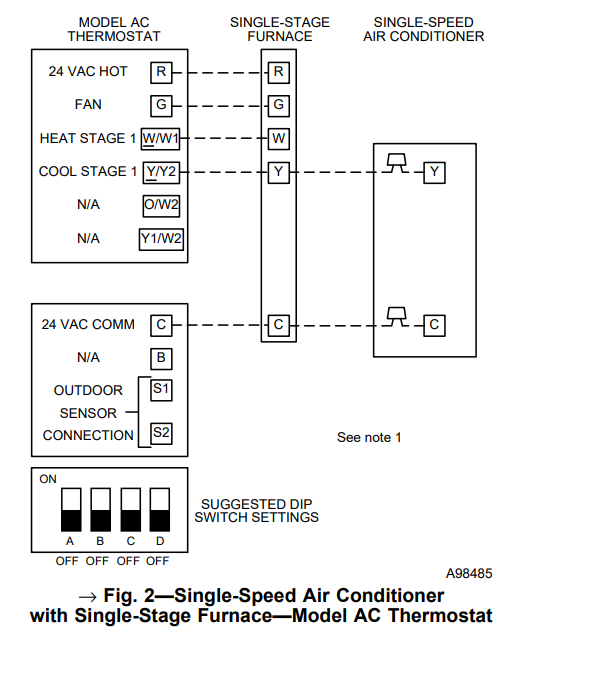
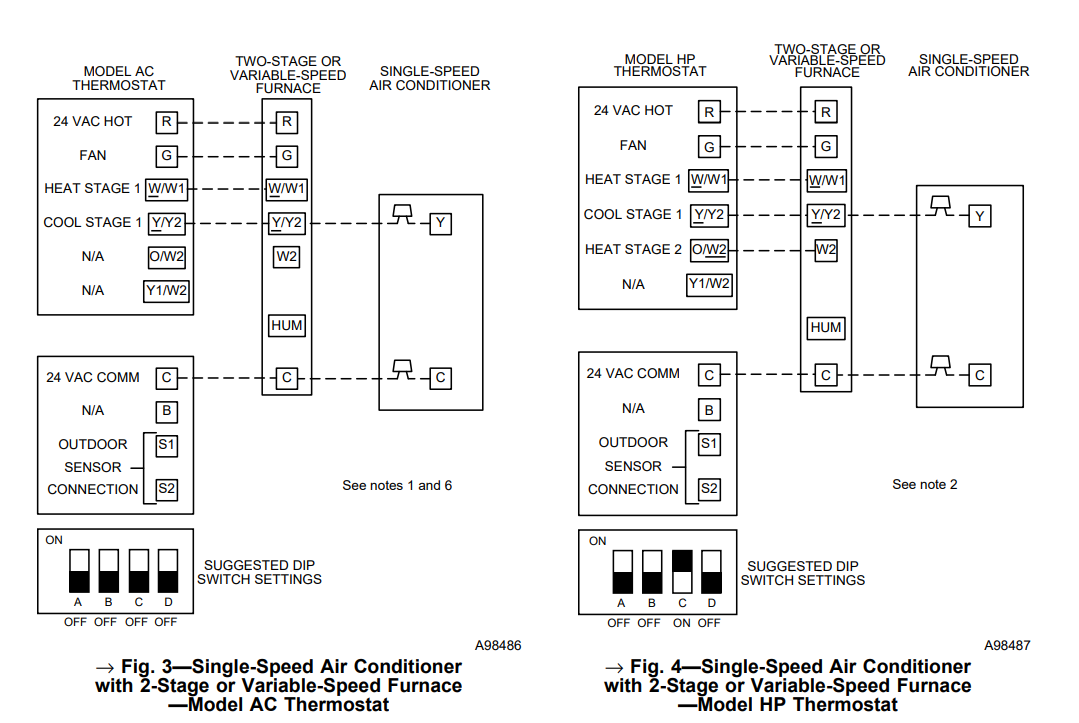

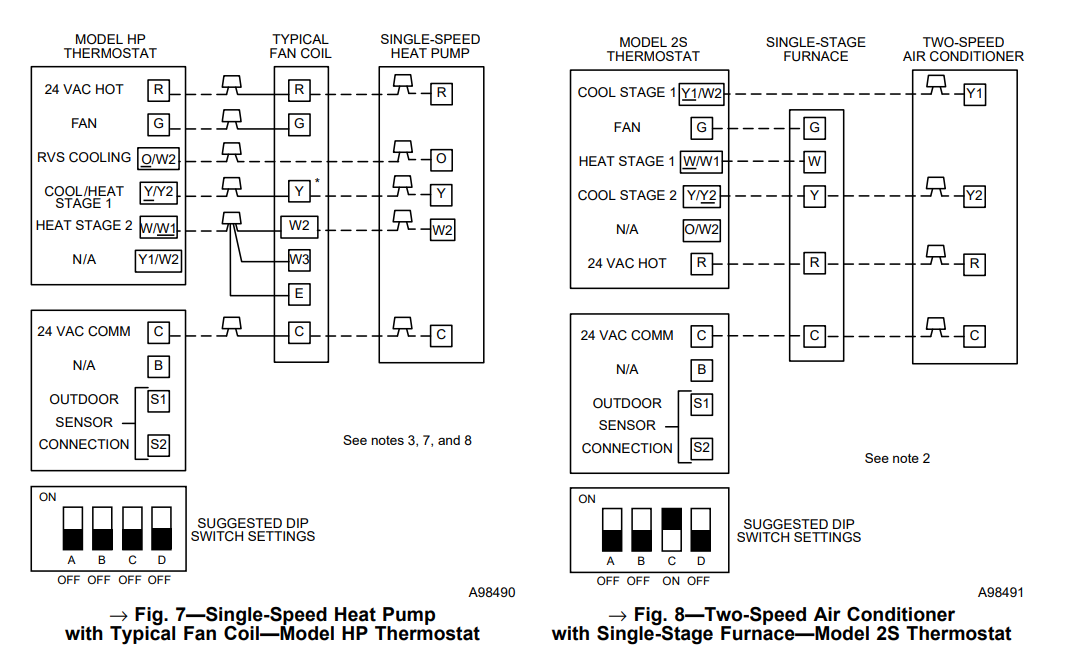
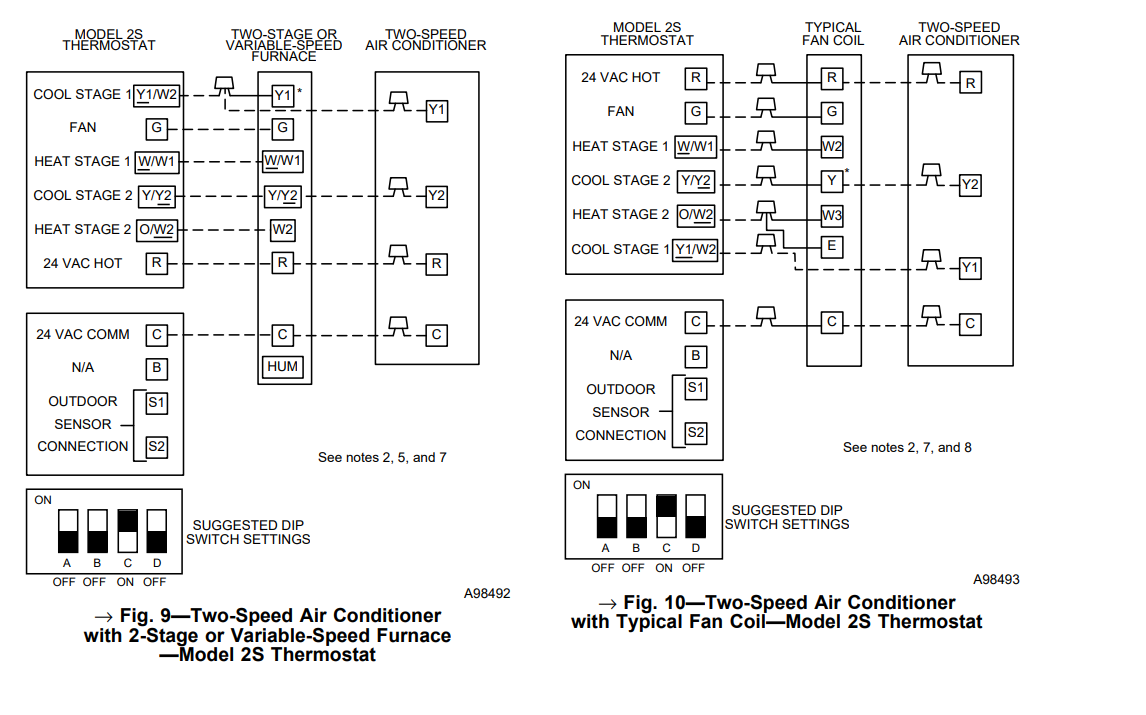
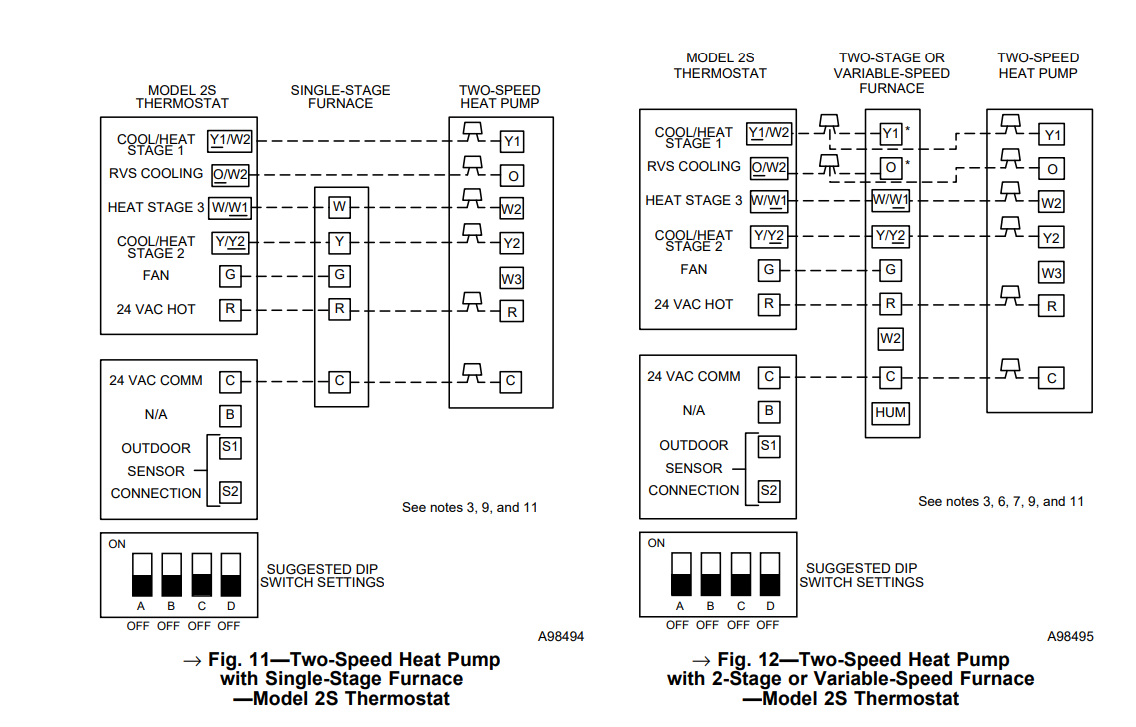
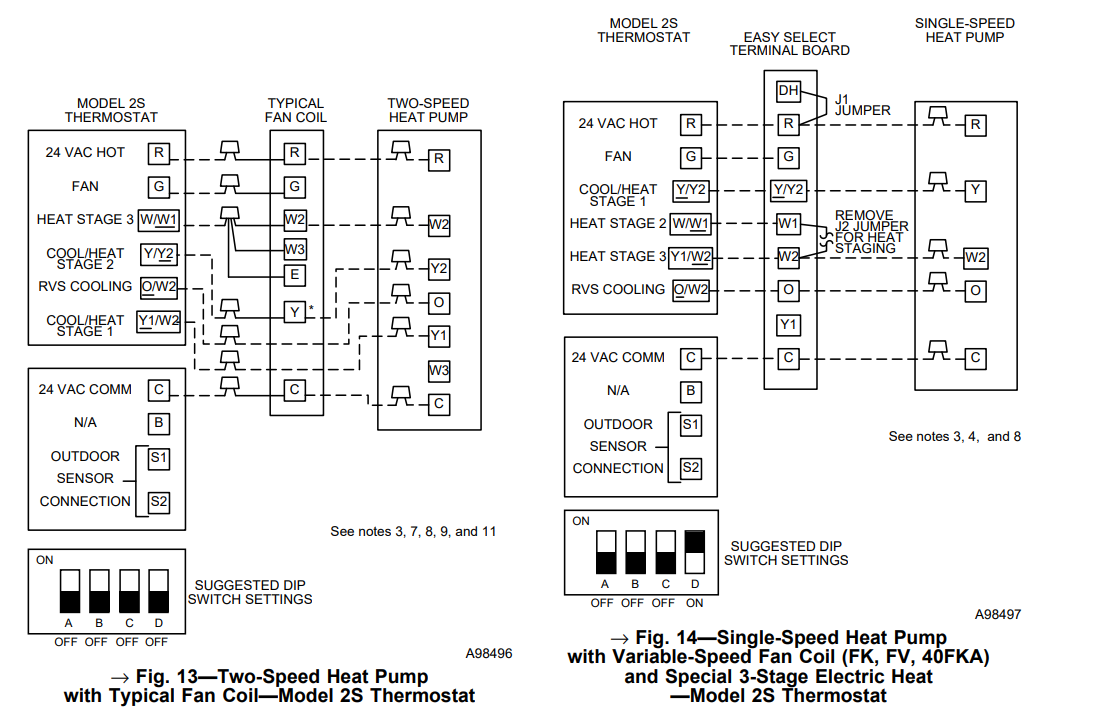
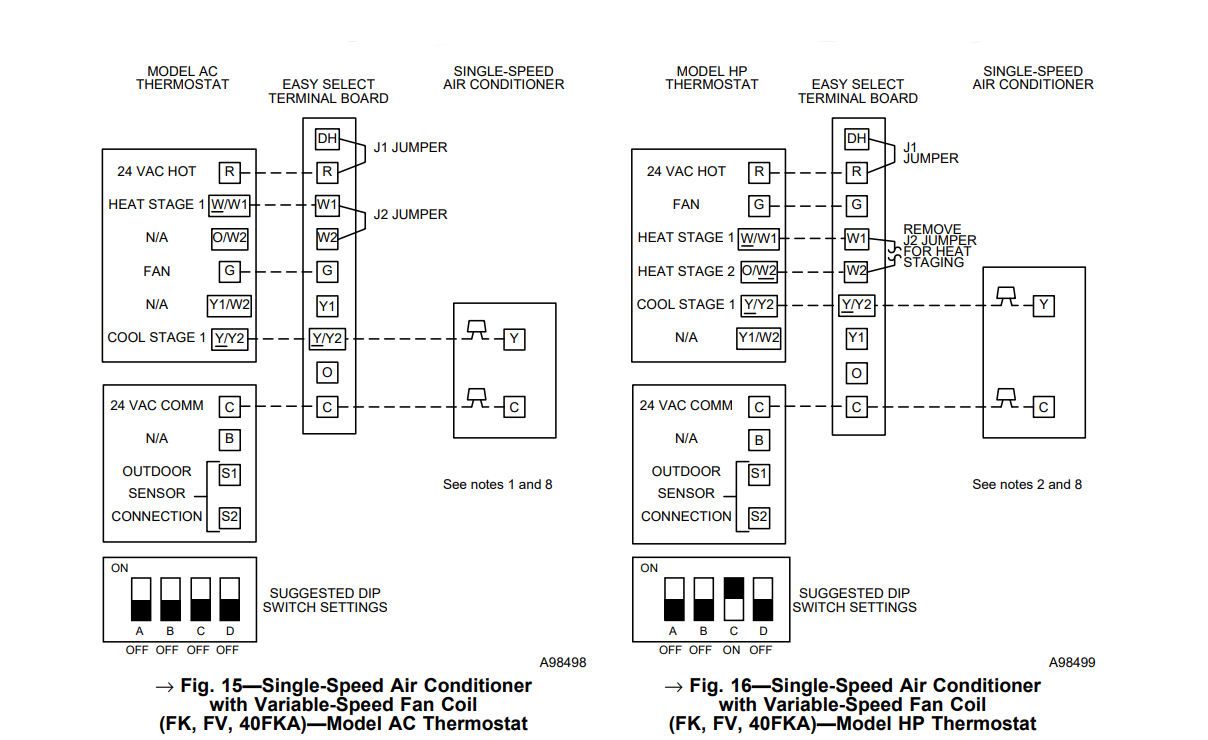
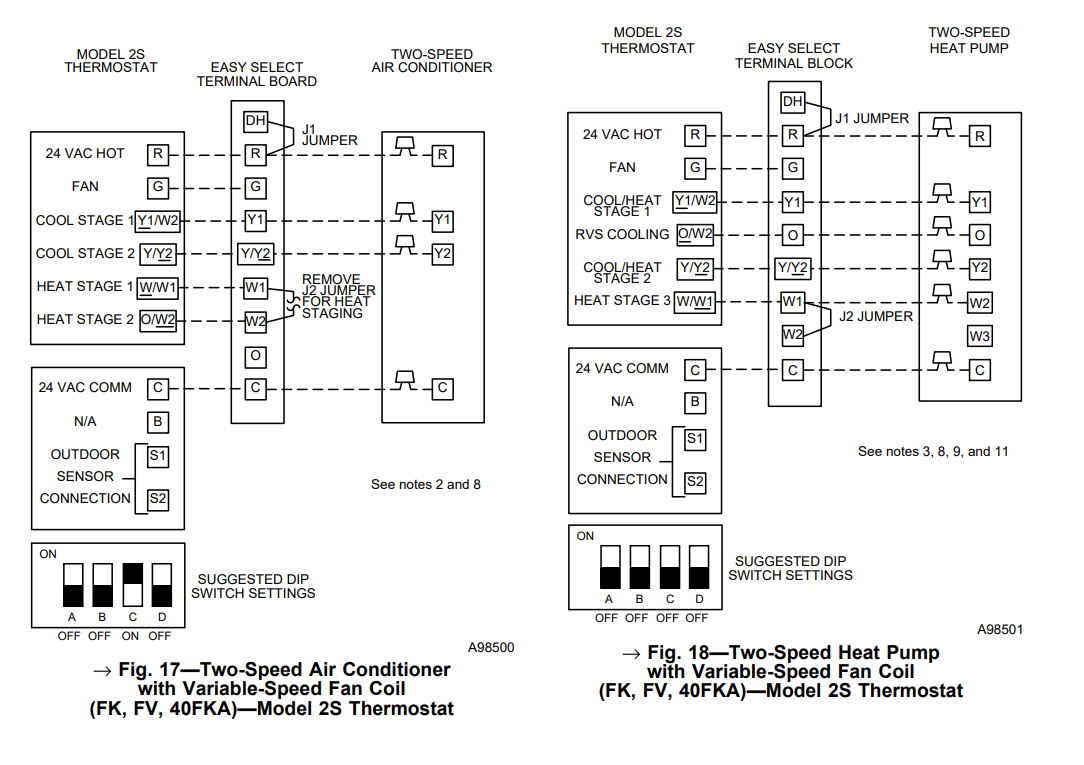
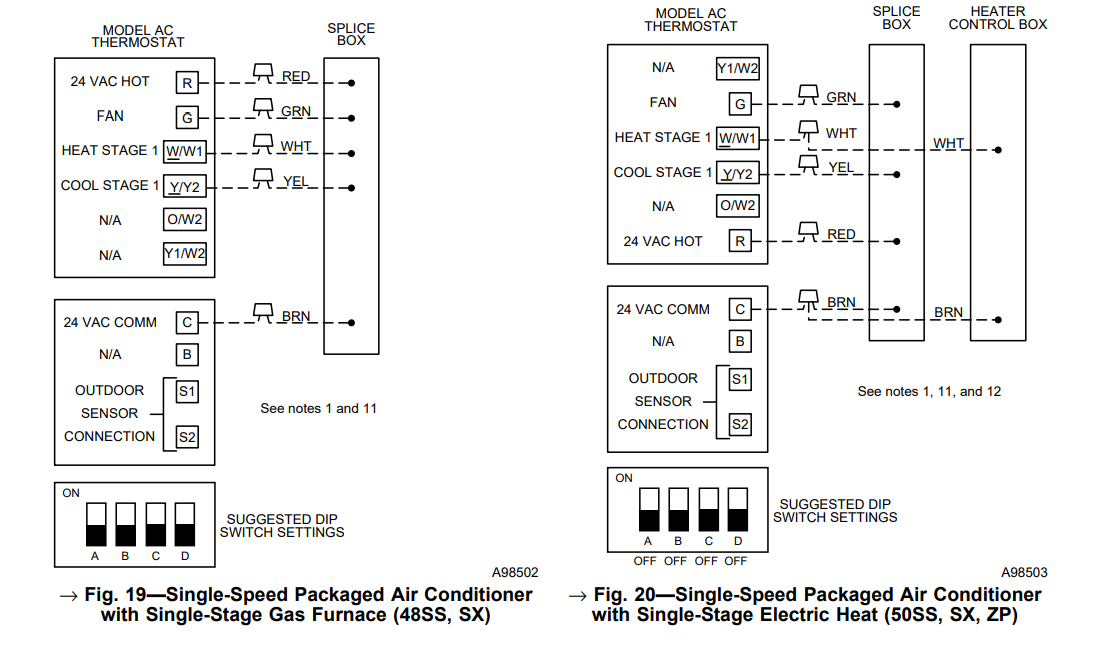
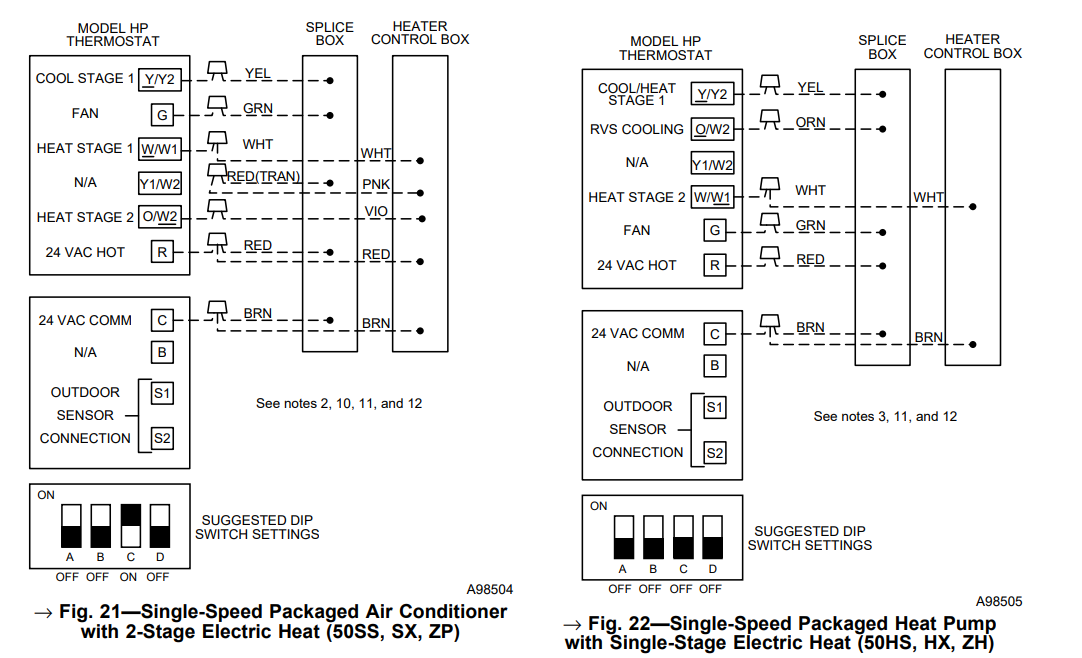
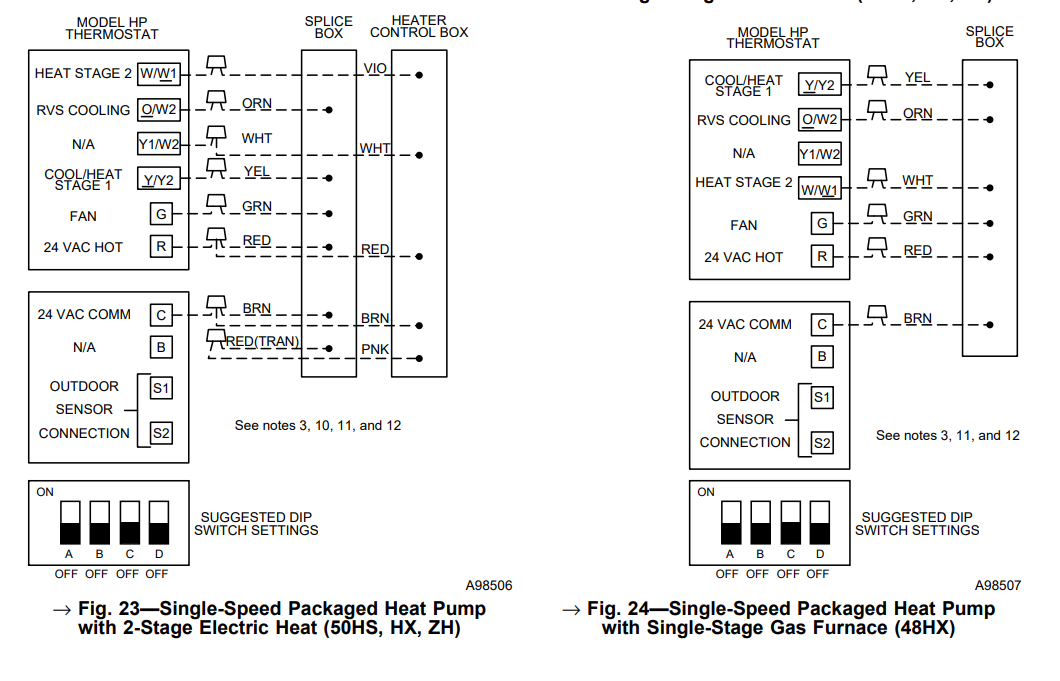
WIRING DIAGRAM NOTES
- The AC model thermostat can only control 1-stage cool and 1-stage heat. Dip Switch-C on has no controlling function and can either be ON or OFF.
- HP and 2S model thermostat MUST have Dip Switch-C ON when installed in air conditioner applications. If required, second-stage heat is controlled by O/W2. Refer to indoor equipment Installation Instructions for proper setup.
- HP and 2S model thermostat MUST have Dip Switch-C OFF when installed in heat pump applications. The reversing valve is controlled by O/W2.
- Intelligent Heat Staging Option: 2S model thermostat with Dip Switch-C OFF and Switch-D ON. This provides single-stage heat pump operation Y/Y2, with three-stage auxiliary heat via W/W1 and Y1/W2. Refer to variable-speed fan coil Installation Instructions. Proper ’intelligent heat capable’ electric heater package must be used.
- As an option, lock the furnace into low-fire operation and let O/W2 control high-fire operation. Refer to indoor equipment Installation Instructions for proper setup.
- Furnace must control its own second-stage heat operation via furnace control algorithm. Refer to indoor equipment Installation Instructions for proper setup.
- Terminals marked with * may not be present on equipment.
- Refer to fan coil Installation Instructions for proper wiring.
- Select the “ZONE” position on the 2-speed heat pump control board.
- Omit red and pink wires from diagram with wiring a 50ZP, ZH with 2-stage heaters.
- Refer to outdoor equipment Installation Instructions for proper setup.
- Program thermostat to bring on G (fan) with any W (heat) selection. See section under “set thermostat configuration.”
OPERATIONAL INFORMATION
- Five-minute Compressor Timeguard
This timer prevents the compressor from starting unless it has been off for at least 5 minutes. It can be defeated for 1 cycle by simultaneously pressing the FAN mode button and the INCREASE TEMPERATURE button. - Fifteen-minute Cycle Timer
This timer prevents the start of a heating or cooling cycle until at least 15 minutes after the last start of the same cycle. Its function is to assure that equipment is not cycled more than 4 times per hour. This timer is defeated for 1 cycle when the desired temperature is manually changed. It can also be defeated for 1 cycle by simultaneously pressing the FAN mode button and the INCREASE TEMPERATURE button. - Fifteen-minute Staging Timer
In multistage heating or cooling, this timer prevents any higher stage from turning on until the preceding stage has been on for 15 minutes. This timer is defeated if the temperature error is greater than 5˚F (usually due to a large change in desired temperature). - Three-minute Minimum On Time
In normal operation, when a stage turns on, it will not turn off for a minimum of 3 minutes. - Heat/Cool Set Points (Desired Temperatures)
A minimum difference of 2 degrees is enforced between heating and cooling set points. This is done by allowing one setting to “push” the other, to maintain this difference. - Auto Changeover
When the auto changeover mode is selected, a change from heat to cool (or vice versa) will not occur until an opposite mode demand has existed for 20 minutes. If the setpoint is changed, the 20 minute requirement is deleted. - Emergency Heat Mode
When thermostat is configured as a heat pump and emergency heat mode is selected, all Y signals are locked out and W becomes energized upon a call for heat. - Power On Check
When AC power is first applied, all segments of the display are turned on for a few seconds. Following this, the temperature display indicates the model/configuration via the following 2 digit code:
AC—1-speed air conditioner, HP—1-speed heat pump, A2—2-speed air conditioner, H2—2-speed heat pump, HS—1-speed heat pump with Intelligent Heat staging (3-stage auxiliary heat). - Error Codes
— — If the thermostat cannot properly read room temperature, the display will indicate “–” (2 dashes) and all outputs (except the fan if on) will turn off. This is to prevent operation of the equipment if the thermostat has failed.- E2 — If the AC line voltage drops below a minimum (brownout) level, all outputs are turned off and the display indicates E2. This condition will remain for 15 seconds after proper line voltage is restored. If the AC line voltage disappears completely, the display will immediately go blank.
- E3 — If thermostat cannot properly read outdoor temperature, and/or it is needed for proper operation, (i.e. Option 8 is ON with no sensor attached), E3 will alternate with room temperature on the room temperature display and the outdoor temperature will read “–“.
- Outdoor Temperature
When an outdoor temperature sensor is attached, outdoor temperature can be read by pressing up and down buttons together. While it is displayed, the letters “od” also appear in the heat set point display. - Smart Recovery
With Smart Recovery selected, the transition out of a heating setback begins 90 minutes early, gradually adjusting room temperature so that the desired temperature will be achieved at the selected time.
Thermostat Troubleshooting
| SYMPTOM | WHAT TO CHECK |
| “–” on temperature display | Temperature sensor reading out of range. Check sensor for damage. If recycyling power does not clear display, thermostat should be replaced. |
| “E2” on temperature display | Brownout condition or too low of voltage to thermostat. Double check wiring and check for 24 VAC between R and C. E2 will clear 15 seconds after proper voltage is restored. |
| “E3” on temperature display | Outdoor temperature reading out of range and needed for Option 8. Check outdoor tem- perature sensor and its wiring. |
|
“Clean Filter” on temperature display |
After the selected number of hours of blower operation “clean filter” will display on LCD. This is to remind the homeowner to “check” filter. Press “reset filter” button to clear dis- play and reset timer to 0. |
|
Cooling will not come on |
Select COOL mode. Decrease cooling setpoint to 10 degrees below room temperature. Simultaneously press FAN and INCREASE TEMPERATURE buttons to defeat timers. Check for 24 VAC at Y/Y2 terminal. If present, thermostat is OK and problem is with equipment or wiring. If not present, replace thermostat. |
|
Heating will not come on |
Select HEAT mode. Increase heating setpoint to 10 degrees above room temperature. Simultaneously press FAN and INCREASE TEMPERATURE buttons to defeat timers. Check for 24 VAC at Y/Y2 (with HP) or W/W1 (with AC) terminal. If present, thermostat is OK and problem is with equipment or wiring. If not present, replace thermostat. |
PROGRAMMABLE THERMOSTAT CONFIGURATION RECORD
- Hardware Configuration
- Switch A Zoning Selection. (OFF = Disable, ON = Enable)
- Switch B Smart Recovery. (OFF = Enable, ON = Disable)
- Switch C Heat Pump Operation. (OFF = Enable, ON = Disable)
- Switch D Intelligent Heat Staging. (OFF = Disable, ON = Enable)
- Mode Settings
- Hold (On or Off)
- Mode (Off, Heat, Cool, Auto, Eheat)
- Heating Set Point Value
- Cooling Set Point Value
- Fan (Auto or On)
- Configuration Options
- 1 Anticipator (1-9: factory default = 3)
- 2 Clean Filter Timer (Off or 1-9: factory default = 2)
- 3 Fahrenheit or Celsius (F or C: factory default = F)
- 4 Fan On with W (Off or On: factory default = Off)
- 5-7 N/A
- 8 Auxiliary Heat Lockout (Off or 5-55°F: factory default = Off)
- 9-12 N/A
- 13 Room Temperature Offset (-5 to +5: factory default = 0)
- 14 N/A
- 15 Enable Auto Mode (Off or On: factory default = On)
- Schedule
WAKE DAY EVE SLEEP
TIME HEAT COOL TIME HEAT COOL TIME HEAT COOL TIME HEAT COOLMon Tue Wed Thu Fri Sat
Sun
SERVICE TRAINING
Packaged Service Training programs are an excellent way to increase your knowledge of the equipment discussed in this manual, including:
- Unit Familiarization
- Maintenance
- Installation Overview
- Operating Sequence
A large selection of product, theory, and skills programs is available, using popular video-based formats and materials. All include video and/or slides, plus companion book.
Classroom Service Training plus “hands-on” the products in our labs can mean increased confidence that really pays dividends in faster troubleshooting, fewer callbacks. Course descriptions and schedules are in our catalog.
CALL FOR FREE CATALOG 1-800-962-9212
[ ] Packaged Service Training [ ] Classroom Service Training
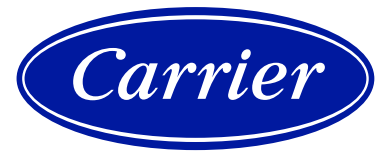
Carrier A98426 Programmable Thermostats Installation Instruction
The post Carrier A98426 Programmable Thermostats Installation Instruction appeared first on thermostat.guide.
source https://thermostat.guide/carrier/carrier-a98426-programmable-thermostats-installation-instruction/
No comments:
Post a Comment